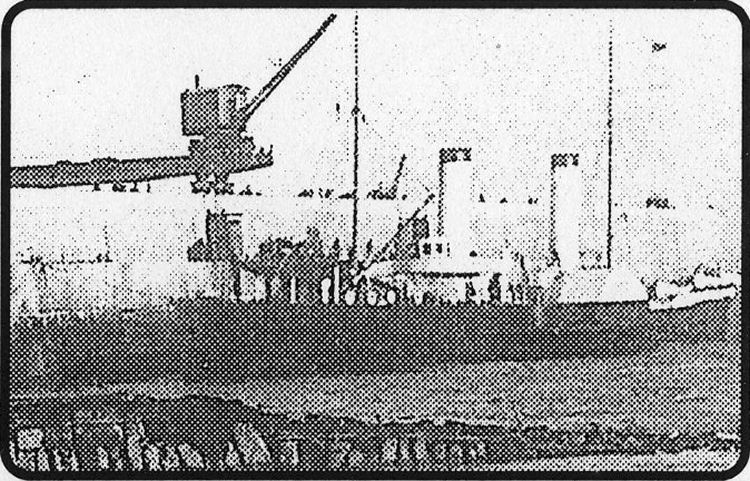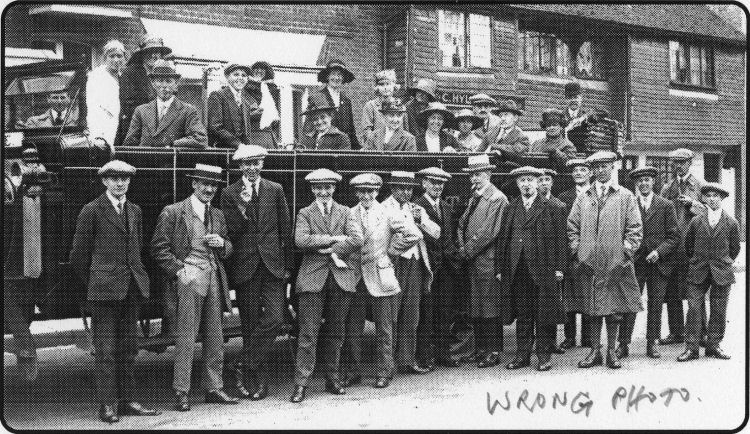
From the Folkestone Herald Published 17 February 2000
Lucky escape.
BRIAN Marshall, of Cow Gate Lane, Hawkinge, kindly gave me the extended loan
of the book Dover and The Great War, a well illustrated work by J.B. Firth,
published by local brewers Alfred Leney & Co Ltd years ago and long out of
print. It has a host of interesting photographs, including ships and Naval
leaders of the brave Dover Patrol, with whom many local seamen and marines
served.
And now Brian has come up with a book extract about a former local ship
wrecked off Devon 86 years ago and the rescue of the crew who were forced to
take to a ships boat.
The brief story is told in Devon Shipwrecks, by Richard Larn and published
by David & Charles, of Newton Abbot, London and Vancouver.
It’s not clear what she was called when she sailed as a steam packet from
Channel ports, but at the time of the wreck, on January 28, 1914, she was
the Bristol-owned Collier.
The author says that the remains of wrecks are not usually visible for long
on the coast of Devon and Cornwall, but the boiler and some iron frames of
the steamer can still be seen.
She was one of the smallest steamers to be lost
on the Devon coast, at 114 tons but, says Richard Larn, the Collier once
sailed as far afield as Australia. In fact she had a remarkable career.
Built in the shipyard of J. Reid, of Port Glasgow, in 1849 she had become
the oldest steamship on Lloyds’ Register when she was lost one day while
making a routine trip on home territory - the Bristol Channel.
Rescue.
On the way to Hayle, in ballast, she was steaming in dense fog, when her
captain and mate on deck saw the red light of Bull Point, which, too late,
warned them they were in great danger. Before they could take evasive action
the vessel went ashore on Rockham beach at dead low water and as the tide
turned she was washed
higher up on the beach and she was stranded — wedged between two rocks.
The Morthoe rocket life saving crew gathered on the clifftop but were too
far away to be of assistance.
Fortunately, however, the steamer’s crew got off in the ship’s punt and they
were picked up by Ilfracombe lifeboatmen who had been towed to the scene by
the steamer Devonia.
Those rescued were Capt Wright, the mate Jefferies, engineer Thomson, two
firemen, three able seamen, a dog, a cat - and a goldfinch in a cage!
As to whether the steamer was called the Collier while steaming across the
Channel, I consulted my copy of the 1939 book English Channel Packet Boats,
by C Grasemann and GWP
McLachlan, published by Syren & Shipping Ltd, who used to produce a
periodical magazine like Ships Monthly, called The Syren. I found an entry
for the steamer Collier all right, but sadly no details as to her builder or
date.

I could not find a picture of the old Collier but this is the paddle
steamer Victoria still in service at Folkestone in 1904.
She was listed as having been on the Newhaven-Dieppe run at the same
time, in 1851, as a single screw steamer Ladybird, and paddle steamers
Culloden, Rothesay and Ayrshire Lassie, all chartered or bought by Mr
Maples, of Shoreham.
Three other paddle steamers, of around 340 tons, built at Port Glasgow in
shipyard not named, came into service at Newhaven in 1852-3.
No reference is made to the Collier’s time at Folkestone or Dover.
Gold Rush!
The writer’s reference to a trip to Australia is interesting. The
Culloden and Rothesay, both built by Denny, of Dumbarton, but found too slow
and uncomfortable for the Newhaven service were returned to the shipyard
and, stripped of their paddles and rigged as schooners, ended up sailing
with emigrants heading for the goldfields of Australia!
Actually the Rothesay was sold en route to meet debts but soon wrecked.
Folkestone Local History Society has made change to its monthly programme
and is holding an open meeting on March 1 when there is a chance to see
material from members’ collections. The planned talk on Hythe School of
Musketry will be at the April meeting instead.

PICTURED outside Folkestone Corporation’s yard in Bradstone Road,
Folkestone, ready for an outing, probably between the wars, are members of
the staff of builders F.W. Clark & Sons, whose business was based at the
Viaduct, in Bradstone Road. The picture was shown to local historian and
author Alan Taylor, by Bert Binfield. Frustrating to me, as a motoring
enthusiast, is the fact there is not enough of the old charabanc showing to
reveal the registration number!
Bob added the note that this was the wrong photo
on his proof of the picture, the 2 March 2000
edition explains the error.
 |
|
1900
Send-off concert for men off to fight in Boer War.
NINETY volunteers of the Buffs, from Folkestone, Lydd,
Dover, Canterbury and Margate, and surrounding areas, were entertained
to a smoking party at Hythe Town Hall given by the Mayor. And, with the
support of family and other guests determined to give them a good
send-off before they embarked for South Africa and the Boer War, the
hall was practically full. The mayor revealed the Hythe company of
volunteers might soon be revived. There was free admission to a “Grand
Arts, Trades & Domestic Exhibition” at Folkestone Town Hall until
February 23 incorporating a free “Biograph” film show with “the latest
War pictures.” Other attractions included a palmist, working with gold
wire electric engraving, sweet making, cookery demonstrations and
concerts. A century ago the invention of an unsinkable lifeboat by
Lionel Lukin, who is burled in Hythe churchyard, was featured In local
papers, his boats having been described In the February issue of The
Lifeboat Journal. Lukin took out a patent In 1785 and prepared a
pamphlet about it in 1806 based on a letter he wrote about his lifeboat
to the Prince of Wales.
|
|
1925
Conference debates chaos of district’s bus services.
THE DEBATE went on about the problems of the local bus services
and Herald writer Felix commented that the East Kent bus company “played
the game” and had a proper timetable but, he said, most of the other
firms' buses “appear to play ducks and drakes with the public." Most
people would agree with him that the situation was little less than a
scandal, he said. The Irony of the problem was that there were too many
buses. Three hundred buses a day left Red Lion square at Hythe every
day; more In summer. The East Kent ran 99 a day. Cllr Maltby, of
Maltby’s Motors, said pooling seemed the only solution. It would end the
racing. 75 years ago the Herald published a lengthy extract of Country
Life articles about the once stately villa of Encombe, at Sandgate, then
the luxury home of Mr & Mrs Ralph Philipson who had come to the district
looking for a ‘pied-a-terre.’ They found an idyllically sited, brick
built and gabled late Victorian seaside residence and an excuse for a
garden, and employed architect Basil lonides to transform it into
something of a Riviera landmark. Felix said the late Sir Stephen Penfold
had one regret, - that was that the Council had not adopted Alderman
Bank's scheme to build a new hall on the former Buzan's Gardens. These
became the site of Lathom Villas.
|
|
1950
Freeman honour for two Folkestone brothers.
TWO WELL known Folkestone brothers claimed an ancient right
and were enrolled as Freemen of Dover - Joseph Iggulden, 56, of Dover
Road, who had run an electrical and cycle business In Folkestone for 39
years, and Edward Charles Iggulden, 54, of Seagrave Crescent, foreman
coach trimmer with Martin Walters at Cheriton Road for many years. They
claimed the Freedom by right of birth, their late father Joseph, who
died In 1946, and uncle Edward Iggulden, 85, both being Freemen of
Dover. Fifty years ago the Herald’s former midweek paper, the Folkestone
& Hythe Gazette, sadly a victim of a nation-wide squeeze a few years ago
now, was recalling the devastating cliff fail which hit the railway line
through the Warren In 1915. Part of the 480ft high cliff collapsed
burying the railway tracks deep with thousands of tons of earth and
chalk. The fall swamped an area of nearly two miles. And the disaster
could have been far worse - had the 6.10 pm Ashford to Dover train not
been a little late. The series of avalanches could have engulfed that
train with great loss of life. Fortunately men carrying red lamps were
able to stop the train. At the time the First World War was raging in
Flanders and there was a shortage of labour. And, incredible as it may
seem today, the line didn’t open again for five years).
|
|
1975
Action demanded to halt attacks on schoolboys.
“STOP the Bully Boys Move, as anger Grows.” That was the
headline story in the Herald 25 years ago when it was reported boys of
Harvey Grammar School had been advised to gather In groups of three or
four when walking to or from school, after boys in grammar uniforms were
singled out for attack by older boys of other schools. One parent told
of boys removing caps and ties to conceal their identity when
approaching “Wyndgate territory." Plans were made to bring
representatives of three local schools to thrash out a solution. The
stately Star and Garter home In Sandgate, home for years of the police
training centre, was being offered for sale by the trustees to Shepway
District Council. The Victorian Society praised The Leas as being one of
England’s outstanding pieces of “Victorian grand scale planning.” And
Shepway Council was being asked to help safeguard the character of the
area, one suggestion being that The Bayle conservation area should be
greatly extended to incorporate the popular promenade and Albion Villas.
There was also a proposal to Include the Plummer Roddis store - now
demolished - and Victorian building groups on Marine Parade, such as
Marine Crescent. Folkestone launched a campaign to halt baby battering
with a blaze of publicity, In the press and on television and radio, as
a 24-hour helpline counselling service was set up, manned by 20
volunteers.
|
|



